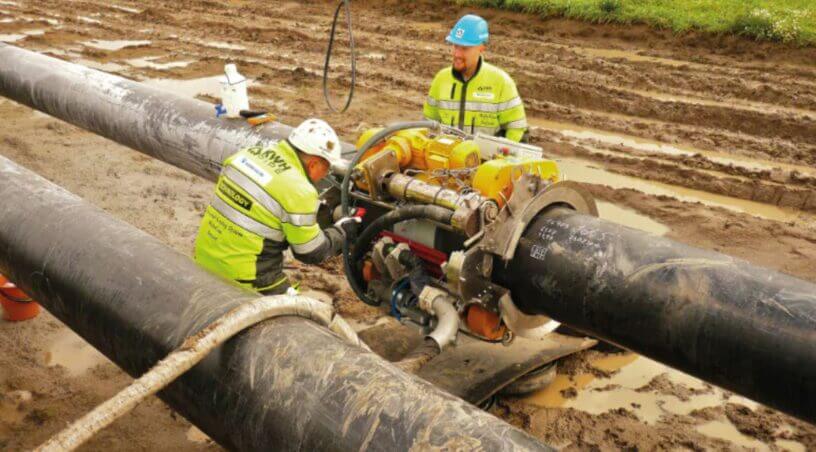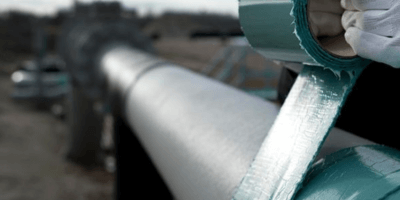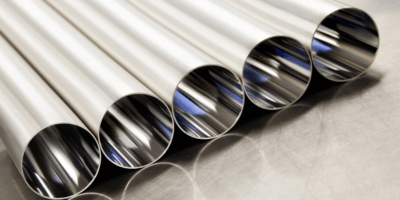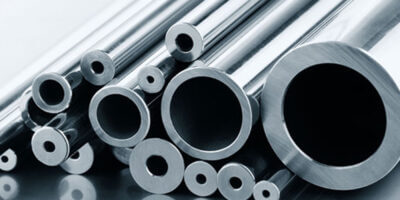What is filed joint coating?
Coated pipes from the factory come with a certain length kept bare near both ends of the pipe. This is usually for field welding (FW) or girth welding (GW). At the site, the pipes are welded at this end. After the weld test procedures are finished, this portion of the pipe with the weld joint has to be coated, before it is buried underground. This is field joint coating.
How field joint coating is different from mainline coating?
Mainline coating has only to ensure adhesion to the pipe surface only, where as field joint coating has to ensure adhesion between the mainline coating and field joint coating. Easy to maintain quality as mainline coating are applied at the factory and there are fewer time constraints, where as it is difficult to maintain quality in field joints as these are applied on the field, also there are time constraints because the coating has to be finished quickly. Mainline coatings can be applied easily in factory conditions, where as field joints coatings has to be applied in extreme environmental conditions.
The following article is an excerpt from ISO-21809-3.
Field joint coating is classified as indicated below per ISO-21809-3:
Hot-Applied Bituminous tapes
Bitumen Also known as asphalt in the United States is formed through the distillation of crude oil. It is viscous and has waterproofing and adhesive properties. Bitumen is primarily used for paving roads and for manufacturing Waterproofing Products. This is a considerably older method and is not commonly employed.
Bituminous tapes normally are comprised of nonwoven synthetic fabric fully impregnated and coated with a flexible, high melting point bitumen compound. These can be single-layer or multi-layer fusible bituminous tapes, hot-applied, with or without primer. The maximum design temperature for these tapes is 30°c.
Application procedure of Bituminous tapes:
- Clean and preheat the surface to be coated.
- Apply a thin coat of compatible primer; allow the primer to dry.
- Heat the bituminous side of the tape until the bitumen becomes liquid and put it with this side down on the surface being coated.
- Heat additionally the outer side and smooth the overlap.
- If the second layer is necessary, install it after heating the surface of the first layer and making it smooth.
Petrolatum tapes
These are anti-corrosion tapes made of a non-woven synthetic carrier fully coated with a modified petrolatum-based compound containing inert fillers. Petrolatum tape coatings consist of a primer and a single layer or multiple layers of petrolatum tapes. The maximum design temperature is 30 °C.
Petrolatum means a thick, greasy, substance with no odor or taste, made from petroleum.
Application procedure of Petrolatum tapes:
- Wipe the surface to remove visible moisture & then prepare the surface.
- Apply a thin coat of compatible primer by brush, by hand, or by another applicable tool.
- Spirally wrap the area being coated with tapes of recommended width, employing the correct overlap and ensuring the complete coverage and adherence of the coating to the pipe surface.
- Apply any outer wrap if recommended by the manufacturer or specified by the purchaser.
Wax tapes
Wax tape coatings consist of a primer and a single layer or multiple layers of wax tapes. The maximum design temperature is 30°C. Click here to know more about wax tapes.
Polymeric tapes
Cold-applied polymeric tape coatings consist of a primer and multiple layers of one or several polymeric tapes. The maximum design temperature is 50°C or 80°C depending on the material.
A polymer is a large molecule made up of chains or rings of linked repeating subunits, which are called monomers. Examples of synthetic polymers include PVC (polyvinyl chloride), polystyrene, synthetic rubber, silicone, polyethylene, neoprene, and nylon. Synthetic polymers are used to make plastics, adhesives, paints, mechanical parts, and many common objects.
Application procedure of Petrolatum tapes:
- Prepare the surface according to the approved method.
- Apply a thin coat of compatible primer (if any); allow the primer to dry.
- Spirally wrap the area being coated with tapes of adequate width, employing the right overlap and using sufficient tension to ensure a complete conformability of the coating. Any tenting effect shall be prevented.
Heat-shrinkable coatings
Heat-shrinkable materials consist of an external backing made of extruded and cross-linked polyolefin and an internal adhesive made of thermoplastic material. The shrinkage of the backing instils a level of circumferential compression in the coating that supplements the bonding of the sleeve to the pipe surface. Heat-shrinkable materials are available in the forms of the tubular sleeve, wrap-around sleeve, tapes, etc.
heat-shrinkable materials based on polyethylene, applied without primer, which can be further subdivided into
- Mastic-adhesive based, typically with a low design temperature of up to 50 °C.
- High shear-strength mastic adhesive, bitumen- or butyl-based, with a design temperature of up to 80 °C
- High shear-strength hybrid or hot-melt adhesive, with a design temperature of up to 120 °C
heat-shrinkable coatings applied with a liquid epoxy or FBE primer can be subdivided into
- Cross-linked heat-shrinkable material based on polyethylene, with a design temperature of up to 120 °C.
- Cross-linked heat-shrinkable material based on polypropylene, with a design temperature of up to 130 °C.
Application procedure of Heat-shrinkable coatings:
- After welding, clean the area with the approved cleaning method.
- Preheat the area to be coated as per manufacturer recommendations.
- Position the sleeve to provide the correct overlap on the plant coating when shrinking is completed.
- Heat the sleeve to the specified surface temperature with a gas torch or other heat source.
Fusion-bonded epoxy (FBE) powder coatings
The coating consists of one or two layers of FBE powder applied to the pipe and cured. Click here to know more about FBE pipe coating.
Application procedure of FBE powder coatings:
- After applicable surface preparation, the field joint area shall be uniformly preheated, using an induction heating coil to a temperature as recommended by the manufacturer.
- The FBE shall be immediately applied once the joint area attains the temperature, with a minimum overlap of 25 mm onto the plant-applied existing coating.
- The coating shall be cured.
Liquid coatings
Liquid epoxy coating
The coating consists of an epoxy resin applied by spray, roller, brush, or trowel.
Liquid polyurethane
The coating consists of a polyurethane resin applied by spray, roller, brush, or trowel.
Fibre reinforced epoxy
The coating consists of an epoxy resin applied by spray, roller, brush, or trowel and reinforced by glass flakes, glass fibers, or glass mats.
Fibre reinforced vinyl ester
The coating consists of a vinyl ester resin applied by spray, roller, brush, or trowel and reinforced by glass flakes, glass fibers, or glass mats.
Cast polyurethane
The coating consists of a polyurethane resin applied by casting.
Application procedure of Liquid coatings:
- After surface preparation of joints area, where applicable heat the area using induction coil or open flame following laid out procedures.
- Apply coating including primer if required.
- The overlap with the plant-applied coating shall be not less than 50 mm.
Polyolefin-based coatings
These are Coatings made from polypropylene (PP) or polyethylene (PE) and with an innermost layer of epoxy resin.
Flame-sprayed polypropylene
The coating consists of two or three layers:
- An epoxy resin layer, applied in the form of powder by dusting or by electrostatic spray, or applied in liquid form by spraying.
- A layer of modified PP powder applied by spraying or flame spraying.
- An optional top layer of PP powder applied by flame spraying.
The maximum design temperature is 110 °C.
Hot-applied polypropylene tapes/sheets
The coating consists of three layers:
- An epoxy resin layer, applied in the form of powder by dusting or by electrostatic spray, or applied in liquid form by spraying.
- A layer of modified PP powder, applied by spraying.
- A top layer of hot-applied PP tape or sheet wrapped in a spiral or wraparound method.
The maximum design temperature is 110 °C or as agreed between the applicator and end user and/or purchaser.
Injection-molded polypropylene
The coating consists of three layers
- An epoxy resin layer, applied in the form of powder by dusting or by electrostatic spray, or applied in liquid form by spraying.
- A layer of modified PP powder, applied by spraying.
- A top layer PP, applied by injection into a mold.
The maximum design temperature is 110 °C or as agreed between the applicator and end user and/or purchaser.
Flame-sprayed polyethylene
The coating consists of three layers:
- An epoxy resin layer, applied in the form of powder by dusting or by electrostatic spray, or in liquid form applied by spraying.
- A layer of modified PE powder, applied by spraying or flame spraying.
- A top layer of PE powder, applied by flame spraying; this powder may be the same modified PE powder applied on top of the first layer.
The maximum design temperature is 70 °C.
Hot-applied polyethylene tapes/sheets
The coating consists of three layers:
- An epoxy resin layer, applied in the form of powder by dusting or by electrostatic spray, or in liquid form applied by spraying.
- A layer of modified PE powder applied by spraying.
- A top layer of hot-applied PE tape or sheet wrapped in a spiral or wraparound method.
The maximum design temperature is 80 °C.
Hot-applied microcrystalline wax coatings
These are coatings made from hot-applied microcrystalline wax.
Microcrystalline wax is a type of wax produced by de-oiling petrolatum. It has much finer and less-distinct crystals and a higher melting point and viscosity than other waxes such as paraffin wax.
These coatings consists of
- A microcrystalline wax applied directly to the surface.
- An outer wrap.
- A final layer of hot-applied wax.
Elastomeric coatings
These are elastomeric coatings using polychloroprene or EPDM. Elastomeric FJC shall be applied only with a plant-applied coating of the same elastomer.
Elastomeric refers to the rubber-like properties of a polymer, i.e., a material being able to regain its original shape when a load is removed from the material.
The coating consists of a thick elastomer applied to a steel surface treated with a primer and a bonding agent.
The elastomer may be
- Polychloroprene, a solid synthetic rubber.
- EPDM is a synthetic ethylene-propylene-diene rubber with higher temperature resistance.
There are two methods to apply the field joint elastomer coatings:
- With the use of a vulcanized split wraparound rubber sleeve.
- With the use of an unvulcanized rubber that is cured in situ.



